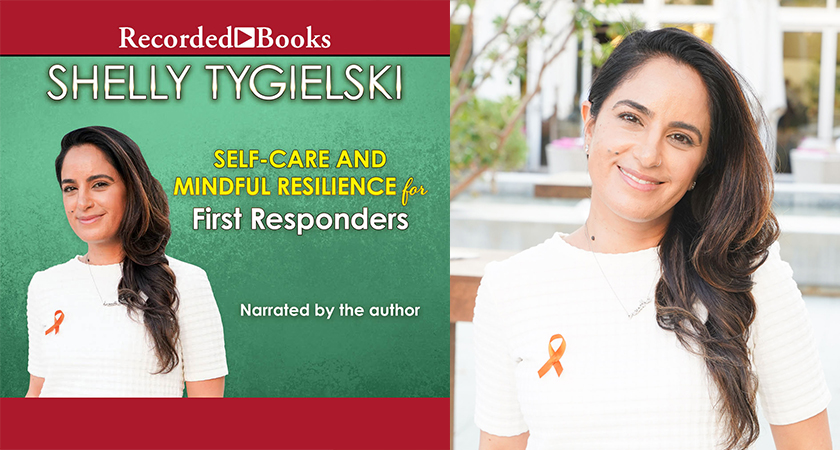Q&A: Shelly Tygielski on Self-Care and Mindful Resilience for First-Responders
December 4, 2020


(Photo Credit: 2019 Red Eye World Photography)
Created for healthcare workers, paramedics, police, and firefighters, “Self-Care and Mindful Resilience for First Responders” consists of eight distinct modules that introduce and teach mindfulness, insight, compassion, guided imagery, and breath work. The goal of compassion-based training is to ensure that first responders limit their exposure to trauma, fatigue, and burnout. This course provides them with tools to combat these potential outcomes of prolonged work in their environment, and it can help them recenter and balance if they are in the midst of experiencing these reactions.
Today Shelly answers our burning questions about “Self-Care and Mindful Resilience for First Responders”—available for purchase on December 15th, 2020 wherever audiobooks are sold.
Author Q&A: Shelly Tygielski
Tell us why you chose to put together this course, especially now, for this distinct population – first responders?
Pre-pandemic estimates were that 30 percent of first responders develop behavioral health conditions including, but not limited to, depression and PTSD. First responders are also reported to have higher suicide attempts and ideation rates than the general population. During this unprecedented time our history, amidst a pandemic, when first responders and front line workers have been called to show up for others, day after day, I wanted to provide a life line for them, as well as their loved ones who are looking for ways to support them in tangible and practical ways.
How does this new audible course provide that life line?
The workshop is broken up into six segments. I first wanted to shed some light on the challenges encountered by first responders and front line workers during regular duty as well as following disasters and help to outline the risks and behavioral health consequences (such as PTSD, stress, and depression) of serving in their roles. The lifeline is to help the listener first understand, identify and then take steps to reduce these risks either on both the individual and institutional levels.
You talk a lot about empathetic distress and burnout, things that are incredibly common in this field. Can you elaborate more on why you thought it was important to spotlight that in particular?
Empathetic distress or compassion fatigue can leave first responders and front line workers feeling dejected, depressed, and even unwilling or unable to provi de compassion or aid in accordance with their jobs. In this course I wanted to clearly define burnout and also the different levels that exist – some that are easier to bounce back from than others. Being in a role where we are expected to have empathy for the people we serve can be seriously exhausting. It’s important, in order to build resilience in these roles, that this population understands the difference between empathy and compassion: With the first, we actually feel the pain of others, and with the second we simply understand how they might feel. And if we constantly choose empathy and take on the pain of others, it can take a toll. Learning to do the latter helps in the long haul, and learning how to identify and tend to signs and reactions, can help in ensuring that longer-term consequences, or prolonged effects, are diminished.
What are some ways that first responders can increase resiliency?
Just a house must be built on a strong foundation, positive mental health starts with a resilient base. There are several ways that first responders can increase resiliency. First, and maybe the most obvious would be to reduce external stressors that are controllable. Another thing they can do is work on maintaining supportive relationships. In other words, it helps to have established support systems that will help them recognize and address mental health challenges before they become full-blown problems. Setting achievable goals has also been proven to help with the cultivation of resilience. Doing so helps provide a realistic and attainable sense of accomplishment and contributes to the increase of self-esteem and confidence. The adoption of healthy coping mechanisms – these are the personal choices that first responders can make to help improve resilience. Things like: engaging in self-care; learning to set boundaries by saying “no” to negative people or unreasonable requests; learning to listen to signals from the body – also known as bio-feedback. The body knows when it is under stress. All of these incremental shifts add up to the foundation that is needed to build resilience.
What are some of the ways that mindfulness has positively impacted first responders and agencies that engaged in the practice?
Mindfulness impacts on first responders and in agencies that have brought in trainings such as MBRT (Mindfulness-Based Resilience Training) have shown up to a 50% decrease in burnout and a 30% reduction in perceived stress, across staff. Staffs have shown significant increases in resiliency and work engagement, contributing to the “bounce back” after encounters with potentially traumatic or stressful incidents. Most important, mindfulness has helped with awareness, attention-training, the cultivation of focus, and the cultivation of emotional intelligence – something that historically has been left out of traditional training in these fields. Yet, its only through this mindfulness awareness and cultivation of compassion that we will be able to heal ourselves and eventually, create the positive shifts we want to see in the world. I think it all starts with that inner journey and the access and adoption of these tools.
